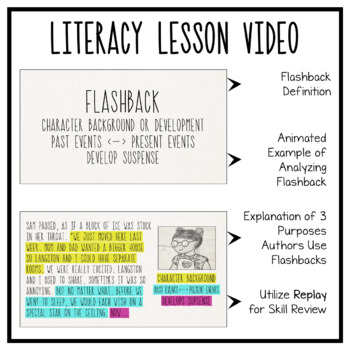Flashback Activities & Video Lesson
- Zip
Also included in
- The Adventures of Hopscotch animated short films and literacy activities bundle is an incredible resource for teaching literary elements! With 9 short films, 9 literary elements video lessons, and 90 activities with editable templates, you will have a wealth of resources to teach characterization, sPrice $48.00Original Price $60.00Save $12.00
- The literary elements activities, graphic organizers, and video lessons bundle is an invaluable resource to any story elements teaching toolkit. The literary elements bundle includes 10 videos that teach characterization, setting, conflict, plot, theme, point of view, tone and mood, symbolism, flashPrice $24.00Original Price $30.00Save $6.00
- The Adventures of Hopscotch: Hopscotch Steps Up animated short films and flashback activities provide a comprehensive set of engaging, rigorous resources for literacy instruction. The materials don’t just tell Hopscotch’s story through an animated, narrated video. They use that story to explicitly tPrice $6.00Original Price $7.00Save $1.00
Description
Flashback Literacy Lesson Video: The flashback video lesson teaches how to identify and analyze why authors include flashbacks in their narratives through an engaging, animated film. Play the lesson whole class, small groups, or assign it individually. With a variety of uses, its ability to be implemented in any and all instructional models makes it a valuable addition to any teaching toolkit. Students can also replay the video to relearn, review, or refresh this literacy skill.
Flashback Activities: The resource includes 9 different flashback activities at varying levels of difficulty. From graphic organizers to comparison drawings, and more, the variety of flashback assignments will allow you to reuse the flashback video lesson and assign different work to students over the course of a unit, semester, or even year. The materials also include a choice board of all the activities if the intended use is for a mini-unit on flashback. Regardless, the variety of activities will allow for flexible implementation and accommodation for all learners.
The activities mentioned above are EDITABLE templates provided in PDF and PowerPoint formats. To use with your chosen mentor text, just fill in basic information, such as titles, character names, scenarios, or excerpts. As templates, they provide flexibility so your students can apply and practice flashback identification and analysis to the variety of texts you use. They offer a range of engaging, rigorous activities aligned to standards to ensure student mastery of this literary element.
Implementation Notes: The implementation notes offer suggestions to maximize learning based on the video and accompanying activities. This includes an outline of how the materials could be used in various instructional models, such as rotation, centers, pull-out groups, and virtual learning. After reading the notes, you will have a better understanding of how you might choose to use the resources to keep students engaged and learning.








